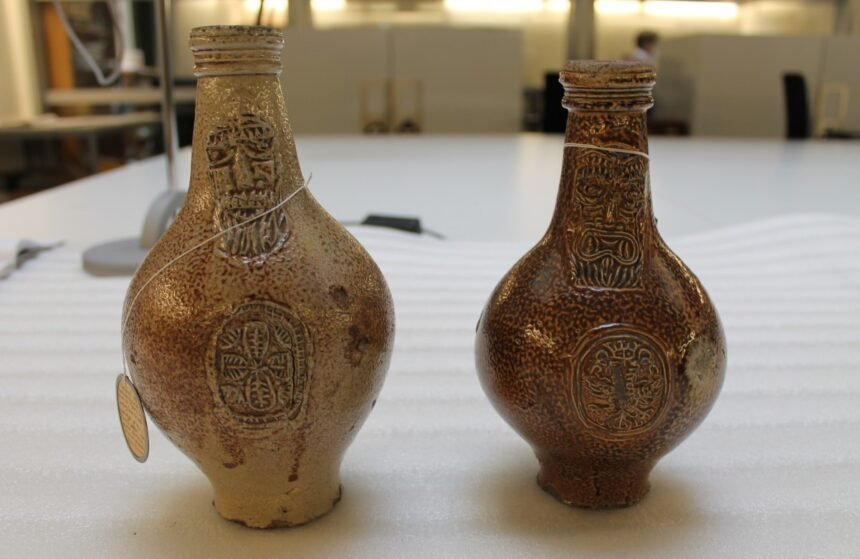The word “Bartmann” may not be familiar to everyone, but for historians, archaeologists, and collectors, it refers to something quite iconic: the Bartmann jug. Also known as the “bearded man jug” or “Bellarmine jug,” the Bartmann is a type of stoneware that became famous during the 16th and 17th centuries. This distinctive pottery is easily recognized by the bearded face that adorns its neck, which has sparked curiosity and fascination for centuries. In this blog post, we’ll explore the rich history of Bartmann jugs, their cultural impact, and their relevance in modern times.
What is a Bartmann Jug?
A Bartmann jug is a type of salt-glazed stoneware that originated in Germany, specifically in the Rhineland region, around the 1500s. The name “Bartmann” comes from the German word for “bearded man,” which refers to the bearded face that is molded onto the neck of the jug. These jugs were typically used for storing and transporting liquids like wine, beer, or water.
The jugs were produced in large quantities and exported throughout Europe, making them one of the most widely recognized types of pottery during that era. The distinctive bearded face on the jug is often thought to represent the figure of a wild man, a popular motif in medieval European folklore. However, the meaning behind the Bartmann face remains a topic of debate among historians and art scholars.
The Origins of Bartmann Jugs
Bartmann jugs originated in the city of Cologne, Germany, during the late 1500s. The city was known for its pottery workshops, and the Bartmann jug became one of its most famous exports. The Rhineland region was ideal for producing stoneware because of its rich deposits of clay, which could be fired at high temperatures to create durable, salt-glazed pottery.
The earliest versions of Bartmann jugs were simple in design, with the bearded face serving as the main decorative feature. However, as the demand for these jugs grew, potters began to add more elaborate designs, including floral patterns, coats of arms, and religious symbols. This evolution in design helped elevate the Bartmann jug from a utilitarian object to a work of art.
The Bearded Face: Symbolism and Interpretations
One of the most striking features of the Bartmann jug is the bearded face that adorns its neck. This face, often with wild, flowing hair and a long beard, has been the subject of much speculation. Some historians believe that the face represents a “wild man,” a figure from European folklore that symbolized nature and untamed wilderness. Others suggest that the face could represent Saint Bellarmine, a Catholic cardinal who was a fierce critic of the Protestant Reformation.
Regardless of the exact meaning, the bearded face became a distinctive element of Bartmann jugs. Its menacing expression was likely intended to ward off evil spirits, making the jug not just a vessel for storing liquids but also a protective talisman. Over time, the Bartmann face became a popular decorative motif, and variations of it appeared on other types of pottery and even in architectural design.
Bartmann Jugs in European Culture
During the 16th and 17th centuries, Bartmann jugs were a common household item across Europe. They were widely used in Germany, the Netherlands, England, and other parts of the continent, where they served as everyday vessels for beer, wine, and other beverages. Because of their durability, many Bartmann jugs have survived the centuries, providing historians and archaeologists with valuable insights into the daily lives of people during this period.
In England, Bartmann jugs became particularly popular during the reign of Queen Elizabeth I. English potters even began producing their own versions of the jug, though these were typically of lower quality than those made in Germany. The widespread use of Bartmann jugs in Europe helped solidify their place as an important cultural artifact, and they remain a favorite among collectors and history enthusiasts today.
The Decline of Bartmann Jugs
The production of Bartmann jugs began to decline in the 18th century as new styles of pottery and glassware became more fashionable. Advances in glass production made glass bottles more affordable, and they eventually replaced stoneware jugs as the preferred vessel for storing liquids. Additionally, changing tastes in art and design led to a decline in the popularity of the Bartmann motif.
Despite this decline, Bartmann jugs never completely disappeared. They continued to be produced in small quantities, particularly in Germany, and remained popular among collectors. Today, Bartmann jugs are valued for their historical significance and artistic beauty, with many examples displayed in museums and private collections around the world.
Modern-Day Interest in Bartmann Jugs
Although Bartmann jugs are no longer produced on a large scale, they continue to captivate historians, archaeologists, and collectors alike. Their durability means that many Bartmann jugs have been unearthed during archaeological digs, particularly in Europe and North America, where they were commonly exported. Each discovery of a Bartmann jug offers a glimpse into the past, revealing details about trade, culture, and daily life in early modern Europe.
In recent years, Bartmann’s jugs have also gained attention in the art world. Contemporary artists and potters have drawn inspiration from the distinctive design of these jugs, incorporating elements of the Bartmann’s face into modern ceramics. This resurgence of interest has helped keep the legacy of the Bartmann’s jug alive, ensuring that this unique form of pottery remains relevant in the 21st century.
How Bartmann’s Jugs Are Valued by Collectors
Bartmann jugs are highly sought after by collectors, especially those with an interest in European history and ceramics. The value of a Bartmann’s jug can vary significantly depending on factors such as age, condition, and the intricacy of the design. Early examples of Bartmann’s jugs from the 16th century are particularly rare and can fetch high prices at auctions and antique shops.
Collectors also place great importance on the provenance of a Bartmann’s jug, with those that have a well-documented history being considered more valuable. Jugs that feature additional decorations, such as coats of arms or religious symbols, are also highly prized. For anyone interested in collecting Bartmann’s jugs, it’s important to consult with experts or research thoroughly to ensure authenticity.
Read more: Understanding NSCocoaErrorDomain: A Comprehensive Guide for iOS Developers
FAQs About Bartmann
A Bartmann jug, also known as a “bearded man jug,” is a type of salt-glazed stoneware that originated in Germany during the 16th century. It is characterized by a bearded face molded onto the neck of the jug and was used for storing liquids like beer and wine.
The term “Bartmann” comes from the German word for “bearded man,” referring to the distinctive bearded face that adorns the neck of the jug. The jug is also sometimes referred to as a “Bellarmine jug,” though the exact origin of that name is debated.
Bartmann’s jugs were primarily used to store and transport liquids such as beer, wine, and water. They were valued for their durability and were exported across Europe during the 16th and 17th centuries.
Bartmann’s jugs are no longer mass-produced, but contemporary potters and artists sometimes create replicas or pieces inspired by the original design. Many historical examples of Bartmann’s jugs can be found in museums and private collections.
The bearded face on Bartmann’s jugs is thought to represent a “wild man” from European folklore or, in some interpretations, Saint Bellarmine, a Catholic figure. The face may have been intended to ward off evil spirits, giving the jug both a functional and protective purpose.
Conclusion
In conclusion, the Bartmann jug is more than just a piece of pottery. It is a historical artifact that offers a window into the culture, art, and daily life of early modern Europe. From its origins in the Rhineland to its widespread use across the continent, the Bartmann jug has left a lasting legacy that continues to fascinate collectors, historians, and art enthusiasts alike. Whether displayed in a museum or found during an archaeological dig, the Bartmann jug remains an enduring symbol of European craftsmanship and creativity.





